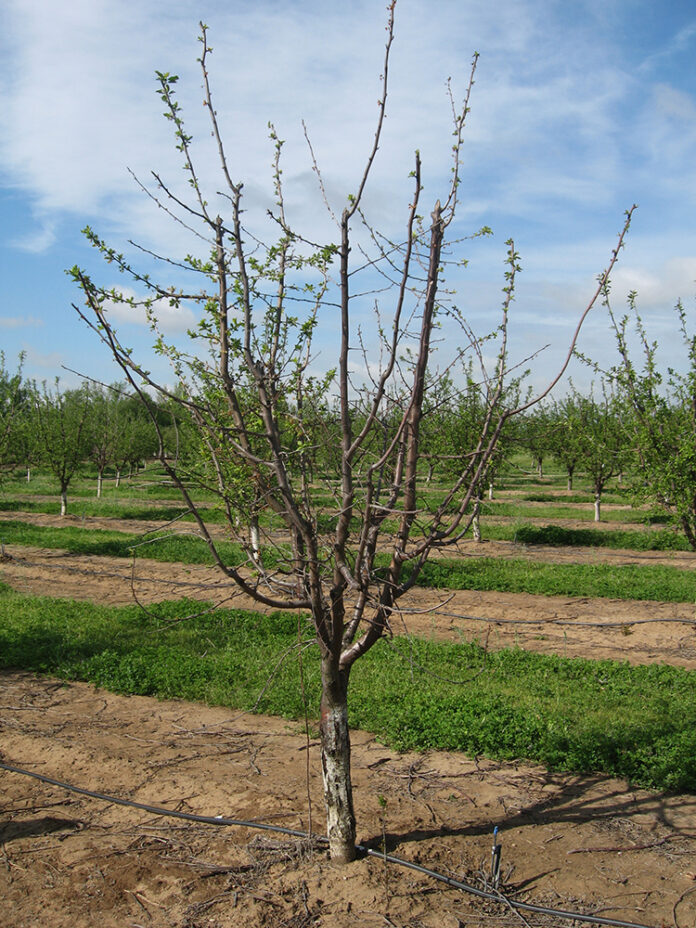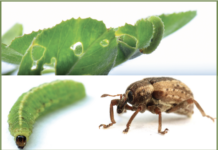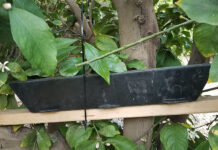In the Sacramento Valley orchard business, the grass is blue and the sky is green. The primary nut crops, almonds and walnuts, are struggling with poor grower returns while cling peaches and prunes are making (some) money. That’s a general reversal of fortunes for the stone fruit crops from the last 15 to 20 years. How long this success will continue is far from certain as both peach and prunes require high management focus and production costs and both face significant international competition. Still, the stone fruit crops in the region are, at least for now, a lifeline for those growers able to put in the management effort to grow a large, quality crop while controlling costs and so help support their entire farming business.
Careful pest management is a key part of delivering a quality crop. Partnering with a knowledgeable PCA/CCA is valuable for all growers, but particularly so for prune growers. Prunes generally have fewer and more manageable pests compared to other crops in the region but have major issues in slow-acting, chronic diseases.
The focuses of this article are the relatively unique pests of prune compared to other common fruit and tree nut crops in the northern growing regions of the state. Many prune pests are familiar to PCAs who grow/work in almonds and/or peaches. These include blossom brown rot, leaf rust, fruit brown rot (monilinia hull rot in almonds), scales (especially San Jose scale), peach twig borer (PTB) and webspinning mites. The common pests of almonds and stone fruit, which should be familiar to PCAs, will be covered briefly.
It is worth noting that, more than any crop grown in the north state, prunes can suffer weather-related crop failures. Since 2004, there have been six years with regional or statewide prune crop failures related to sudden hot or extended cool weather at bloom. In those years, alert PCAs are often the key to careful use of a limited budget to maintain orchard health and prepare for next year.
Insect and Mite Pests
The key insect and mite pests of prunes are aphids, peach twig borer (PTB), webspinning mites, and scale. Two of the four general pest groups (webspinning mites and scale) are often controlled by natural predators as long as they are preserved by careful, selective pesticide use to control the remaining pests of note (aphids and PTB).
Aphids
Two aphids, mealy plum aphid (MPA) and leaf curl plum aphid (LCPA), are the key pests of prune. High populations of plum aphid feeding in prune trees in the spring and into the summer can reduce tree size, fruit sugar and return bloom.
These aphids have similar life cycles and so are managed similarly. Both species move into prune orchards in the fall, mate and lay eggs in the late fall. Eggs hatch during prune bloom. Aphid populations can increase rapidly in warm springs, ‘outrunning’ biological control from many natural enemies including ladybugs, lacewings, etc. Plum aphids move out of prune orchards in the late spring (LCPA) or summer (MPA) as shoot growth slows, although they can remain into the summer in young, vigorous orchards with active shoot growth. MPA spend their summers in an alternative host such as reed grass or cattails. LCPA spend the summer on plants of the Asteraceae (daisy) plant family (daisies, sunflowers, thistles, etc.)
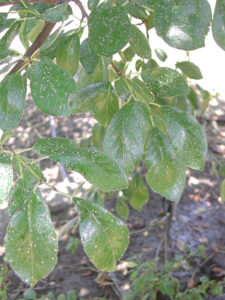
There is no economic threshold for MPA when monitoring before bloom. Finding a single aphid egg in an orchard means that orchard should be sprayed based on UC IPM Guidelines. Finding no eggs in the dormant season doesn’t mean they aren’t present, so many growers and PCA manage aphid using orchard history. Where there is a history of aphid feeding in the orchard, many PCAs treat preventatively with a research-proven low rate of pyrethroid in the late fall or winter (the bottom of the labeled rate for Asana or Warrior were very effective in controlling both species in many UC field studies in fall or dormant timings the last 20 years.)
Because pyrethroids that drift or runoff to creeks and ditches can harm aquatic life (see article at the end of the column), effective but not excessive use rates are an easy first step to reducing environmental risk with these materials. Solid but not excessive pyrethroid rates (for example, 6 to 8 oz/acre Asana) delivered excellent peach twig borer control in multiple UC trials over many years. These rates also deliver excellent aphid control. What about pesticide resistance? Alternating peach twig borer control chemistries (e.g., dormant spray one year, B.t. at bloom the next year) is an effective way to manage pesticide resistance without the environmental risk of high rates of pyrethroid use.
Two applications of 4% oil during bloom is also effective in smothering aphid and does not harm the prune flowers or fruit set. If no pre-bloom or bloom sprays are applied, growers and/or PCAs should monitor orchards after bloom for signs of aphid colonies. See post-bloom monitoring practices in the references at the end of this column. Even if aphid spray(s) were applied, it’s a good idea to spot-check areas of the orchard where spray coverage might have been sketchy (e.g., row ends near a road, structures, etc.) Systemic or translaminar materials such as neonicotinoids (Assail, Actara, imidacloprid), BeLeaf or Movento are effective on post-bloom colonies as the curled leaves can shelter the pests from direct contact with pesticides. Use of neonics and/or pyrethroids after bloom can harm beneficial insects that control spider mites or scale. Post-bloom, oil does give good control where it reaches aphids (won’t get into curled leaves). However, using oil after bloom risks smothering parasitoid larvae along with aphid.
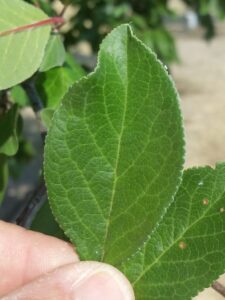
![]()
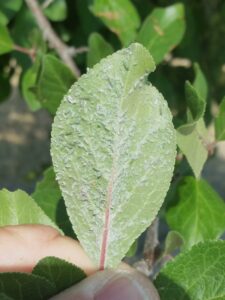
Peach Twig Borer
Peach twig borer (PTB) is a regular pest of prune and could be considered a key pest, and is one that often results in unacceptable damage and so frequently must be controlled. Fruit skin damaged by PTB feeding is an entry point for brown rot fungi. Growers report a good PTB management program helps control fruit brown rot, especially in years and/or locations where orchard humidity and infection risk is increased as fruit mature (late July/early August). As mentioned above, dormant pyrethroid sprays deliver effective PTB control. Another option are bloom sprays containing B.t. (DiPel, Javelin, etc.). This is the only recommended bloom insecticide; others harm bees.
Miss dormant or bloom spray for PTB? Post-bloom applications of Intrepid or Altacor can control PTB too without flaring mites when orchard monitoring shows a need and used to time sprays. Monitor PTB after bloom using pheromone traps and degree day calculations using the program described in the Prune Pest Management Guidelines (ipm.ucanr.edu/agriculture/prune). A treatment threshold is included in the guidelines.
Mites and Scale
Webspinning (spider) mites and scale can be controlled by natural predators in many orchards by avoiding in-season use of broad-spectrum pesticides such as pyrethroids or neonics. See monitoring details for spider mites in the references including treatment thresholds. Scale, especially San Jose scale, should be monitored during the dormant period and treated if populations exceed the threshold described.
Diseases of Fruit, Flowers and Foliage
Three major fungal diseases of fruit, flowers and foliage can impact prunes: blossom brown rot, fruit brown rot and leaf rust. All are best controlled by fungicide(s) applied before rainfall and the disease infections promoted by the wetness.
Blossom brown rot is controlled by one or two fungicide sprays during bloom. In a dry year, one spray around 50% bloom is needed to control infections promoted by dew. See the UC IPM Fungicide Efficacy and Timing publication (ipm.ucanr.edu) for information on fungicide selection.
Wet weather at or soon after full bloom can contribute to lacey scab. This is not a disease, but a scar-tissue that forms on the skin of rapidly growing fruit soon after bloom. Captan or Bravo at full bloom reduces this cosmetic damage that if extreme can reduce fruit grade (strange that a fungicide would reduce damage not from a fungus, but that’s the research results.)
Leaf rust is controlled by sulfur or synthetic fungicides (FRAC 3 or 11) applied ahead of rain in the late spring or summer.
Wet or humid conditions promote fruit brown rot infections as the fruit “sugars up” just ahead of harvest. Fungicides, especially those with FRAC 3 materials (Tilt, Tebuzol, Quash, etc.) give the best control possible when sprayed ahead of infection. Good spray coverage is needed to protect fruit from infection, so higher spray volumes (e.g., 140 to 150 gallons/acre vs 70 to 100 gallons/acre) deliver the best control in UC trials. Adding 415 spray oil (1 to 2 gallons of oil/100 gallons water) helps cut the waxy coating on the fruit and allows better coverage. Every other row spraying doesn’t control disease on the far side of the tree from the sprayer.
Bark cankers and wood rot diseases
The 900-pound gorilla in prune pest management is bark or wood disease(s). Prune trees can be killed outright by these diseases, suddenly or slowly depending on the pathogen. Many of these diseases do the most damage to stressed trees.

Bacterial canker (bac canker) is just that, a bacterial infection of tree bark which enters trees stressed by ring nematodes (usually), poor nitrogen nutrition and/or other stressors like soil hardpan. This disease is active in wet, cold weather. Activity dies down as temperatures warm in the spring. There is no effective control measure when the stressors listed are present. Bac canker often hits young trees two to five years old. Where ring nematode is found in ahead of planting, preplant fumigation is recommended but may not completely control the nematodes. The best approach for bac canker control is to use rootstocks more tolerant of ring nematode than the Mariannas (M2624, M29C, Myro root, etc.) What are those? In recent prune rootstock trials, ‘Improved French’ trees on Lovell or Viking rootstock had a higher survival percentage than the current industry standard rootstocks M2624 and M29C. In the same study, trees on Krymsk 86 rootstock also survived better than those on M2624 and M29C.
Fungal cankers are another major killer of prune trees. Cytospora (and other pathogen species such as Botrysphaeria and Phomopsis) enter prune trees though damaged bark such as sunburn, oil burn and/or pruning cuts. Practices to protect prune trees from infection include protecting trunk bark with white paint, leaving the interior of the tree “shaggy” to shade scaffold wood and/or spraying thiophanate-methyl (Topsin-M, etc.) fungicide on pruning cuts immediately after pruning. While other fungicides may provide some protection of pruning wounds from canker pathogens, thiophanate-methyl most consistently controlled infections in UC trials.
Finally, wood rot fungi (Phellinus pomaceus, previously known as Phellinus tuberculosus) causes rapid and early decline of prune orchards. This slow-growing fungus is believed to enter trees through pruning wounds. Broken limbs and scaffolds generally begin to appear after 10th leaf, but infections are believed to occur years earlier. To maintain a productive orchard, pruning practices early in the life of the orchard should include thiophanate-methyl during dry weather to avoid infection. This might seem crazy, but not as much (or as painful) as a perfectly good prune orchard falling apart after year 10.
Other pests that damage prune orchards are not unique to prunes such as gophers and weeds. Information on the control of those can be found in the usual spots including ipm.ucanr.edu.
The major, unique pests of prunes are aphids and canker diseases as reviewed above. The UC IPM Pest Management Guidelines for prunes and plums are being revised this spring, so more information and resources (images, effective pesticides) will soon be available.
In the meantime, here’s to hoping the prune crop will set well this spring and orchardists in the Sacramento Valley will have decent crops across all acres.
References
Monitoring aphids
ipm.ucanr.edu/agriculture/prune/springsummer-monitoring-for-aphids/
Pyrethroids in surface water
sacvalleyorchards.com/blog/common-concerns/protecting-sacramento-valley-waterways-from-pyrethroid/
Dormant season scale monitoring
ipm.ucanr.edu/agriculture/prune/dormant-spur-sample/
Prune disease references
ipm.ucanr.edu/agriculture/prune/brown-rot-blossom-and-twig-blight/
ipm.ucanr.edu/agriculture/prune/russet-scab/
ipm.ucanr.edu/agriculture/prune/brown-rot-on-fruit/
sacvalleyorchards.com/prunes/diseases-prunes/cytospora-signs-management/
sacvalleyorchards.com/prunes/diseases-prunes/update-on-heart-rot-in-prunes/
https://www.growingthevalleypodcast.com/podcastfeed/phellinus











